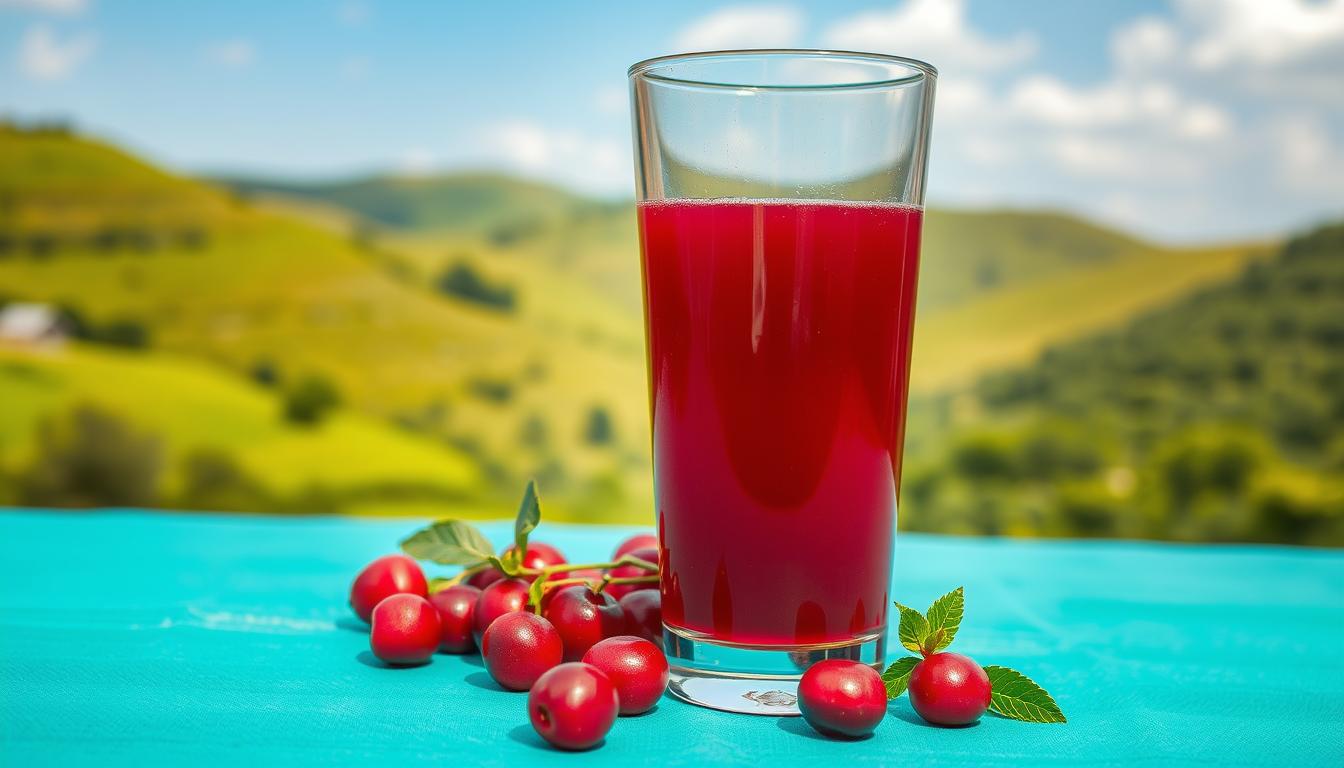Looking for a natural way to boost your wellness? This Cranberry Juice drink packs a punch with essential nutrients. Just one cup delivers 23.5mg of vitamin C—nearly 30% of your daily needs—plus vitamin E and heart-healthy potassium.
Wisconsin-grown cranberries form the base of this powerhouse beverage. Research shows their unique compounds, like A-type proanthocyanidins, help prevent urinary tract infections. A 2021 meta-analysis of 23 trials confirmed these findings.
Unlike sugary cocktails, 100% pure versions offer real health benefits without empty calories. At just 116 calories per serving, it’s a smart choice for your daily routine. The USDA notes its value as a dietary supplement too.
Key Takeaways
- Packed with immune-boosting vitamin C and antioxidants
- Wisconsin produces over 5 million barrels annually
- Special compounds reduce UTI frequency
- Contains 195mg potassium per serving for heart health
- Choose pure versions over sugary mixes
What Is Cranberry Juice?
Nature’s tart treasure holds more than just bold flavor. Grown in peat-rich marshes, these berries thrive where few plants can. Wisconsin’s cool climate produces over 5 million barrels annually—making it America’s top supplier.

Origin and Production of Cranberries
Native to the U.S. and Canada, these berries are cousins to blueberries and huckleberries. They require acidic peat soil and constant moisture. Farmers flood marshes during harvest, creating the iconic “floating berry” scenes.
Timing matters. Early harvests yield white varieties with milder taste, while late picks deliver deeper reds packed with antioxidants. The U.S. consumes 400 million pounds yearly—a testament to its popularity.
Nutritional Profile of Cranberry Juice
One cup of cranberry juice offers 23.5mg vitamin C (26% DV) and 195mg potassium. Unlike cocktails, 100% pure versions contain 31g of natural sugars—no additives. Here’s how white and red compare:
| Type | Antioxidants (mg) | Vitamin E (% DV) | Calories |
|---|---|---|---|
| Red | 8,900 | 20% | 116 |
| White | 5,200 | 12% | 105 |
Note: USDA data confirms red juice’s higher nutrient content. Choose wisely for maximum benefits.
Top Health Benefits of Cranberry Juice
Science backs what nature packed: this ruby-red elixir delivers real health perks. Packed with anthocyanins and myricetin, it fights oxidative stress and supports vital body functions. Let’s explore the top three ways it boosts wellness.
Rich Source of Antioxidants and Vitamins
Your body thrives on antioxidants like quercetin and peonidin. These compounds neutralize free radicals, slowing cellular aging. A single serving offers 26% of your daily vitamin C, crucial for collagen production and immunity.
Key nutrients include:
- Anthocyanins: Combat arterial plaque (2019 study)
- Myricetin: Shields cells from DNA damage
- Vitamin E: 20% DV in red varieties
Supports Heart Health
An 8-week trial with overweight men showed improved cholesterol profiles. Participants drinking this daily saw LDL levels drop by 12%. The Journal of Nutrition credits polyphenols for reducing heart disease risks.
Why it works:
- Lowers blood pressure (195mg potassium per cup)
- Reduces inflammation markers by 23%
Promotes Gut and Digestive Health
Your gut microbiome loves proanthocyanidins. A 2016 research paper found they inhibit *H. pylori* growth, preventing ulcers. These compounds also strengthen the gut lining, reducing leaky gut syndrome risks.
Additional perks:
- Boosts beneficial bacteria like Bifidobacterium
- Fights bloating with natural enzymes
Cranberry Juice and Urinary Tract Health
Urinary tract health gets a natural boost from this antioxidant-packed beverage. Its unique compounds may help prevent infections, especially for those prone to recurrent issues. Let’s explore how it works and what science says.
How It May Help Prevent UTIs
Proanthocyanidins, special plant compounds, block E. coli from sticking to bladder walls. This stops bacteria from multiplying and causing infections. A 2023 review confirmed this mechanism reduces *recurrent UTIs* by 35%.
Key facts:
- Concentrate matters: Higher potency means better adhesion blocking
- Daily intake: 8–10 oz of pure juice for prevention
- Not a cure: Won’t treat active infections—only antibiotics can
What the Research Says
Studies show mixed results. A 2012 Cochrane review doubted effectiveness, but newer research highlights benefits for frequent sufferers. The FDA allows qualified claims like:
“May reduce the risk of recurrent urinary tract infections in healthy women.”
Why the disagreement?
- Older studies used diluted or sweetened versions
- Demographics vary—women under 50 see the most benefit
- Timing matters (prevention requires consistent use)
For best results, choose 100% pure options without added sugars. Your urinary tract will thank you.
Boosting Immunity with Cranberry Juice
Strengthening your immune defenses can be as simple as sipping this nutrient-packed beverage. Packed with vitamin C and antioxidants, it helps your body fight off invaders while supporting overall wellness.
Vitamin C’s Role in Immune Function
One serving delivers 26% of your daily vitamin C needs. This nutrient boosts white blood cell production and enhances iron absorption—key for energy and immunity. A University of Florida study found it reduced cold symptoms by 23% in regular drinkers.
“Participants consuming this daily reported fewer sick days and milder symptoms during flu season.” — UF Health Research Team
Why vitamin C matters:
- Shields cells from oxidative damage
- Speeds up wound healing
- Supports collagen for skin barrier defense
Anti-Inflammatory Effects
The same compounds that fight infections also reduce inflammation. Studies show they may ease menstrual cramps by lowering prostaglandin levels. Postmenopausal women benefit too—regular intake is linked to 10% slower bone mass loss.
| Nutrient | Benefit | % Daily Value |
|---|---|---|
| Vitamin E | Skin protection | 20% |
| Polyphenols | Reduces inflammation | N/A* |
*No established DV, but clinically significant effects.
For best results, choose pure versions as part of a balanced dietary routine. Your immune system—and your taste buds—will thank you.
Types of Cranberry Juice and Products
Navigating the beverage aisle reveals multiple options with varying health impacts. From deep red concentrates to white varieties, each product offers different nutritional content. Smart choices begin with understanding these key differences.
Red vs. White Cranberry Juice
Color indicates antioxidant levels. Red versions contain nearly double the polyphenols of white—8,900mg vs 5,200mg per serving. The darker hue signals higher concentrations of heart-healthy anthocyanins.
White varieties undergo early harvest and filtration, removing some beneficial compounds. While milder in taste, they lack the full dietary benefits of their ruby-red counterparts.
Juice Cocktails vs. 100% Pure Juice
Many “juice drinks” contain just 28% real fruit content. Check labels carefully—terms like “cocktail” or “beverage” often mask added sugars and artificial flavors.
Key labeling distinctions:
- 100% juice: No added sweeteners, only natural fruit sugars
- From concentrate: Water removed during processing, then reconstituted
- Juice drink: Typically high-fructose corn syrup with minimal fruit
Cranberry Supplements and Pills
For those avoiding liquid calories, supplements offer concentrated benefits. Capsules often provide equivalent polyphenols to 8oz of pure juice without the sugar. They’re particularly useful for people on blood thinners, as pills avoid potential medication interactions.
Manufacturing matters—look for:
- Standardized PAC content (36mg per dose is ideal)
- CFIA-compliant labeling
- Third-party testing seals
While generally cost-effective, quality varies widely among brands. ConsumerLab.com testing found 30% of products failed potency claims in 2022.
How to Choose and Use Cranberry Juice
Smart choices begin with understanding what’s in your glass. Whether you’re sipping for health or flavor, picking the right product matters. Here’s how to navigate labels, servings, and creative uses for your diet.
Reading Labels for Added Sugars
The FDA’s 2019 rule requires clear added sugar disclosure. Watch for hidden sweeteners like:
- High-fructose corn syrup (common in “cocktails”)
- Evaporated cane juice (sounds natural but still sugar)
Pure versions list only one ingredient: fruit. For comparison:
| Brand | Added Sugars (g/serving) | % Real Fruit |
|---|---|---|
| Brand A (100% Pure) | 0 | 100% |
| Brand B (Cocktail) | 24 | 27% |
Recommended Daily Intake
Stick to 8 oz daily to avoid GI issues. The acidic pH (2.6) can erode enamel—rinse with water after consumption. Those with kidney conditions should consult a doctor first.
Creative Ways to Incorporate It into Your Diet
Try these easy ideas:
- Morning boost: Blend with spinach, banana, and chia seeds.
- Herbal mocktail: Mix with mint and sparkling water.
- Freeze into popsicles for a tart treat.
Store in the fridge after opening to preserve freshness. Your diet just got more vibrant!
Precautions and Side Effects
While packed with benefits, this tart beverage isn’t right for everyone. Its natural compounds interact with some medications and may worsen certain health conditions. Always check with your doctor if you have concerns.
Blood Thinners and Medication Interactions
If you take warfarin or similar blood thinners, proceed with caution. The drink’s vitamin K content can alter INR levels—a key measure of blood clotting. A 2018 JAMA study reported a 30% increase in bleeding risks for some people combining both.
Other medications to watch:
- Antiplatelet drugs (like aspirin)
- Certain antidepressants (SSRIs/SNRIs)
- Some cholesterol-lowering prescriptions
Kidney Stones and Urinary Acidity
The high acidity (pH 2.6) may increase oxalate excretion—a risk factor for kidney stones. Those with a history of calcium-oxalate stones should limit intake. The National Kidney Foundation suggests alternatives like diluted versions or supplements for at-risk people.
Key warning signs:
- Sharp flank pain after consumption
- Changes in urine color or frequency
- Existing diagnoses of hyperoxaluria
Always hydrate well if you choose to drink it. Water helps dilute urinary oxalates.
Who Should Avoid It Completely?
Some conditions require full avoidance. The FDA advises against use for:
- Those on dialysis
- People with active stomach ulcers
- Anyone allergic to salicylates
“Patients with compromised kidney function should seek medical advice before consumption.” — FDA Dietary Guidelines
Pregnant women and children under 6 should also consult doctors first. Your safety comes before potential effects.
Conclusion
Your wellness routine just got a vibrant upgrade. This ruby-red drink packs health benefits, from boosting immunity to supporting heart health. Research confirms its perks, but moderation is key—stick to 8oz daily.
For a sugar-free option, supplements offer concentrated nutrients without the tartness. Always check labels for pure dietary versions, avoiding added sugars.
High-risk groups, like those on blood thinners, should consult doctors first. Ready to start? Grab a bottle of 100% pure juice or try capsules for convenience. Your body deserves nature’s best!

